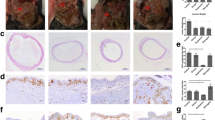Abstract
Objective
To determine the effects of etanercept (anti-TNF-α) on surgically induced endometriosis in a rat model.
Materials and methods
This is a prospective, randomized, controlled, experimental study that was carried out at the Experimental Research Center of Yeditepe University (YUDETAM). Thirty female nonpregnant, nulligravid Wistar-Hannover albino rats were used. The summary of the technique: surgical induction of endometriosis, administration of estrogen for 2 weeks, and laparotomy; administration of etanercept for 2 weeks following the induction of endometriosis and laparotomy; administration of estrogen for 2 weeks and necropsy. The volume and histopathological scores of the endometriotic foci were evaluated.
Results
One-hundred twenty uterine horns were implanted in 30 rats. Endometriosis was completely formatted in 112 lesions (93.3%). No rats were lost. In the etanercept group, the lesions’ volumes were 83.9 ± 13.1, 47.2 ± 8.4, and 96.7 ± 34.8 mm3 at the end of the second week (pretreatment stage), at the end of the fourth week (post-treatment stage), and at the end of the sixth week, respectively (P = 0.007). Histopathologic scores were 2.3 ± 0.2, 1.7 ± 0.2, and 1.9 ± 0.1, respectively (P = 0.08). The changes in the other groups were not statistically significant.
Conclusions
Etanercept, a fusion protein consisting of human recombinant soluble TNF receptor-2, neutralizes TNF activity. Anti-TNF therapy could be a new non-hormonal therapeutic option for the treatment of endometriosis in humans.
Similar content being viewed by others
References
Oral E, Arici A (1997) Pathogenesis of endometriosis. Obstet Gynecol Clin North Am 24(2):219–233
Nezhat F, Shamshirsaz AA, Yildirim G (2009) Pelvic pain, endometriosis, and the role of the gynecologist. In: Altcheck A, Deligdisch L (eds) Pediatric, adolescent and young adult gynecology, 1st edn. Wiley, New Jersey, pp 174–194
Vernon MW, Wilson EA (1985) Studies on the surgical induction of endometriosis in the rat. Fertil Steril 44:684–694
Guney M, Oral B, Karahan N, Mungan T (2008) Regression of endometrial explants in a rat model of endometriosis treated with melatonin. Fertil Steril 89(4):934–942
Eisermann J, Gast MJ, Pineda J, Odem RR, Collins JL (1988) Tumor necrosis factor in peritoneal fluid of women undergoing laparoscopic surgery. Fert Steril 50:573–579
Barrier BF, Bates GW, Leland MM, Leach DA, Robinson RD, Propst AM (2004) Efficacy of anti-tumor necrosis factor therapy in the treatment of spontaneous endometriosis in baboons. Fertil Steril 81:775–779
Yildirim G, Attar R, Ozkan F, Kumbak B, Ficicioglu C, Yesildaglar N (2010) The effects of letrozole and melatonin on surgically induced endometriosis in a rat model: a preliminary study. Fertil Steril 93(6):1787–1790
Yesildaglar N, Yildirim G, Attar R, Karateke A, Ficicioglu C, Yilmaz B (2010) Exposure to industrially polluted water resulted in regressed endometriotic lesions and enhanced adhesion formation in a rat endometriosis model: a preliminary study. Fertil Steril 93(5):1722–1724
Demirbag S, Cetinkursun S, Tasdemir U, Ozturk H, Pekcan M, Yesildaglar N (2005) Comparison of hyaluronate/carboxymethylcellulose membrane and melatonin for prevention of adhesion formation in a rat model. Hum Reprod 20(7):2021–2024
Demirbag S, Atabek C, Guven A, Oztas E, Surer I, Ozturk H, Yesildaglar N (2009) Effects of pyrolytic carbon on postoperative adhesion formation in rats. Arch Gynecol Obstet 279(1):11–15
Uygur D, Aytan H, Zergeroglu S, Batioglu S (2006) Leflunomide—an immunomodulator—induces regression of endometrial explants in a rat model of endometriosis. J Soc Gynecol Investig 13:378–383
Keenan JA, Williams-Boyce PK, Massey PJ, Chen TT, Caudleb MR, Bukovsky A (1999) Regression of endometrial explants in a rat model of endometriosis treated with the immune modulators loxoribine and levamisole. Fertil Steril 72:135–141
Paul Dmowski W, Braun DP (2004) Immunology of endometriosis. Best Pract Res Clin Obstet Gynaecol 18:245–263
Kyama CM, Overbergh L, Debrock S, Valckx D, Vander Perre S, Meuleman C et al (2006) Increased peritoneal and endometrial gene expression of biologically relevant cytokines and growth factors during menstrual phase in women with endometriosis. Fertil Steril 85:1667–1675
Agic A, Xu H, Finas D, Banz C, Diedrich K, Hornung D (2006) Is endometriosis associated with systemic subclinical inflammation? Gynecol Obstet Invest 62:139–147
Arici A, Oral E, Attar E, Tazuke SI, Olive DL (1997) Monocyte chemotactic protein-1 concentration in peritoneal fluid of women with endometriosis and its modulation of expression in mesothelial cells. Fertil Steril 67:1065–1072
Arici A (2002) Local cytokines in endometrial tissue: the role of interleukin-8 in the pathogenesis of endometriosis. Ann N Y Acad Sci 955:101–109
Bullimore DW (2003) Endometriosis is sustained by tumour necrosis factor-alpha. Med Hypotheses 60:84–88
Shakiba K, Falcone T (2006) Tumour necrosis factor-alpha blockers: potential limitations in the management of advanced endometriosis? A case report. Hum Reprod 21:2417–2420
Roux CH, Brocq O, Breuil V, Albert C, Euller-Ziegler L (2007) Pregnancy in rheumatology patients exposed to anti-tumour necrosis factor therapy. Rheumatology 46:695–698
Koninckx PR, Craessaerts M, Timmerman D, Cornillie F, Kennedy S (2008) Anti-TNF-a treatment for deep endometriosis-associated pain: a randomized placebo-controlled trial. Hum Reprod 23(9):2017–2023
Falconer H, Mwenda JM, Chai DC, Song XR, Cornillie FJ, Bergqvist A, Fried G, D’Hooghe T (2008) Effects of anti-TNF-mAb treatment on pregnancy in baboons with induced endometriosis. Fertil Steril 89:1537–1545
Katz JA, Antoni C, Keenan GF, Smith DE, Jacobs SJ, Lichtenstein GR (2004) Outcome of pregnancy in women receiving infliximab for the treatment of Crohn’s disease and rheumatoid arthritis. AmJ Gastroenterol 99:2385–2392
Aytan H, Caglar P, Uygur D, Zergeroglu S, Batioglu S (2007) Effects of the immunomodulator leflunomide on the induction of endometriosis in an experimental rat model. Fertil Steril 87:699–702
Altintas D, Kokcu A, Kandemir B, Cetinkaya MB, Tosun M (2008) Efficacy of imiquimod, an immunomodulatory agent, on experimental endometriosis. Fertil Steril 90(2):401–405
Acknowledgment
We thank Russell Fraser for checking the English of the manuscript.
Conflict of interest statement
No conflict of interest or financial support to declare.
Author information
Authors and Affiliations
Corresponding author
Rights and permissions
About this article
Cite this article
Yildirim, G., Attar, R., Ficicioglu, C. et al. Etanercept causes regression of endometriotic implants in a rat model. Arch Gynecol Obstet 283, 1297–1302 (2011). https://doi.org/10.1007/s00404-010-1543-9
Received:
Accepted:
Published:
Issue Date:
DOI: https://doi.org/10.1007/s00404-010-1543-9



